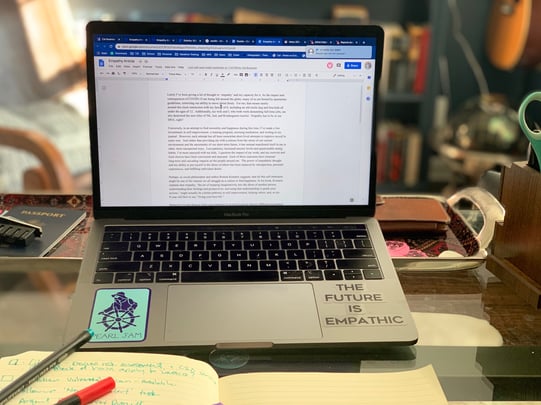
Lately I’ve been giving a lot of thought to ‘empathy’ and my capacity for it. As the impact and consequences of COVID-19 are being felt around the globe, many of us are bound by quarantine guidelines, restricting our ability to move about freely.
For me, that means nearly around-the-clock interaction with my family of 6, including an old senile dog and four kids all under the ages of 12. Additionally my wife and I, who both work demanding full-time jobs, are also bestowed the new titles of 5th, 2nd, and Kindergarten teacher. Empathy has to be in our DNA, right?
Conversely, in an attempt to find normality and happiness during this time, I’ve made a few investments in self-improvement: a running program, morning meditation, and writing in my journal.
However, each attempt has all been somewhat short-lived to improve myself in some way. So, rather than providing me with a release from the stress of our current environment and the uncertainty of our short-term future, it has instead manifested itself in me in other, more unexpected ways.
Less patience, increased anxiety levels and questionable eating habits. I’m more annoyed with my kids, I question the impact of my work, and my exercise and food choices have been convenient and unsound. Each of these outcomes have returned long-term and cascading impacts on the people around me. The power of empathetic thought and my ability to put myself in the shoes of others has been replaced by introspection, personal experiences, and fulfilling individual desire.
4.jpg?width=940&name=Cal%20Blog%20(empathy)4.jpg)
Perhaps, as social philosopher and author Roman Krznaric suggests, that all this self-obsession might be one of the reasons we all struggle as a culture to find happiness. In his book, Krznaric explains that empathy, “the art of stepping imaginatively into the shoes of another person, understanding their feelings and perspectives, and using that understanding to guide your actions,” might actually be a better pathway to self-improvement, helping others, and, as my 8-year old likes to say, “living your best life.”
However, it’s one thing to write your intention in an article and an entirely different proposition to actually create and implement this pathway forward. So, how do we do this?
First, we should start by observing and asking questions. To put ourselves in the shoes of others and build a foundation to understand how they interact with the environment around them, we should think more in terms of users and their experiences, not specs, features and outcomes.
For example, here’s an exchange between myself and my 6-year old daughter, who was experiencing some friction with her older sister:
“Daddy (sobbing), can you punish Mila?”“Why, honey?”
“Because she yelled in my face and it scared me.”
“Why did she yell in your face?”
“Because she was mad that I was being silly.”
“How were you being silly?”
“Because I was making silly faces and noises close to her face.”
“Did she like you making silly noises in her face?”
“I don’t know…”
“Did she ask you to stop?”
“Yes.”
“Did you stop?”
“No.”
“Then what happened?”
“She yelled in my face.”
“Then what did you do?”
“I came down here to tell you.”
“And what do you think you could have done? ”
“Not make noises in her face.”
::end scene::
7.png?width=951&name=cal%20blog%20(empathy)7.png)
At some point, we’ve all had this same approach to problem solving; we first put forward a solution before we really even understand the true problem. And, typically, because it’s “my idea,” it’s got to be the one and only solution.
My first reaction was more likely to ask my other daughter to go to her room and think about why she yelled and scared her little sister. Problem solved (wipes hands clean), what’s next?
However, by asking questions and trying to understand the interaction between the sisters, taking the first solution would have actually been counterproductive to solving the problem.
Here’s how: the older sister would’ve pouted in her bed wondering why she was being disciplined for protecting her personal space, and the little sister, who would’ve had no consequences to her own actions, would likely have been in her sister’s face again later that afternoon, simply reinforcing the cycle of arguments between the two.
By building empathy and understanding the people, their experiences and their pain-points, we can then begin to more tightly frame the problem alongside those experiencing them—using the layers of context and feedback—as the basis for meaningful solutions. Rather than focusing on self-improvement through personal gain, I was able to build upon my character by putting others first.
By building on my capacity for empathy and better understanding their emotions and desires, we will be better positioned to guide our actions to accomplish what we had intended to in the first place: Living our Best Life.
.jpg?width=175&name=TS%20-%20Transform%20Protect%20logo(mini).jpg) WE TRANSFORM & PROTECT
WE TRANSFORM & PROTECT
We Transform & Protect by putting People Before Technology. We believe that the technology your business relies on should be used to drive transformation and lead to a seamless user experience. In uncertain times it’s important to partner with people and companies you can trust. Think|Stack was built for situations like this, to help those who weren’t.
If you’re unsure what to do next or if you have questions about your technology, our Think|Stack tribe is here to help, contact us anytime.
About the Author

Cal Bowman
VP Strategy & Innovation


.jpg)

-1.jpg)
